A Tour of Mesopotamian War Cemeteries in 2003
- Home
- World War I Articles
- A Tour of Mesopotamian War Cemeteries in 2003
In the early summer of 2003, fortunately or not, I found myself and the Battalion I was commanding at the time, 7 Air Assault Battalion REME, based just outside of Al-Amarah in what had once been the British front line in Mesopotamia. Wherever I am in the world if there is an opportunity to visit a CWGC site then I will. A quick look on the map and Al-Kut Al-Kūt, (also spelled Kut al-Imara or Kut El Amara) didn't look too far away, albeit it was in a sector of Iraq under the control of the Americans. Quite whether it looked as close when Major General Townsend decided to make a push for Baghdad in the summer of 1915 via Al-Kut, I can only speculate. A quick call to my Brigade Commander and the US liaison officer and the trip was on. We would RV with a US Marine Corps escort at Blair Field outside of the city, and they would take us in; but how did it all start?
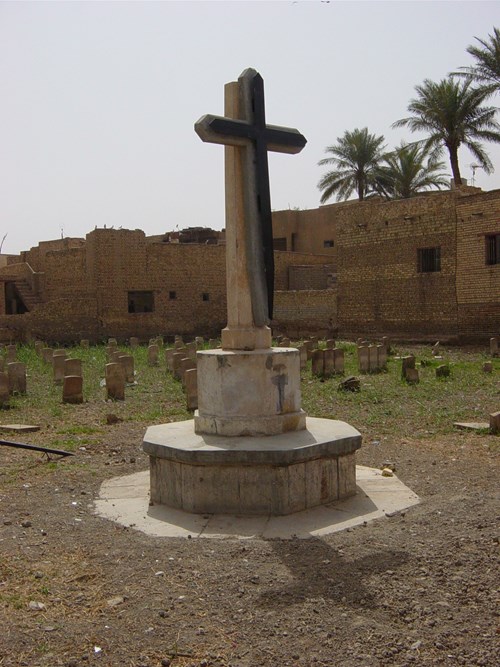
Above: The Cross of Sacrifice at Kut War Cemetery (US Forces having replaced the sword on the facing of the cross)
British and Indian troops took control of the strategic city of Basra and the surrounding areas in November 1914 having first landed on the Al-Faw Peninsula on 6 November 1914, just one day after hostilities between Britain and Turkey were officially declared. This gave them control of the significant southern oil fields, which would guarantee fuel supplies to the Royal Navy and secure the entrance to the mighty Shatt al-Arab waterway. Strategically this is all that was really needed, however with Mesopotamia (modern day Iraq) in the hands of the Ottoman (Turkish) Empire, seen by many to be the sick man of Europe, there was an opportunity for further imperialistic expansion. The taking of Basra had cost the 6th (Poona) Division 489 dead, including 170 from the Dorsetshire Regiment, compared to over 1,500 Turkish troops. Boyed on by relatively easy success in the capture of Basra there were already suggestions of advancing on Baghdad; something which was well outside the capability of the small force. Nevertheless there was an advance of some 40 miles to Qurna, where the Tigris meets the Euphrates; the point claimed to be the site of the Garden of Eden with Adam’s Tree still standing today.
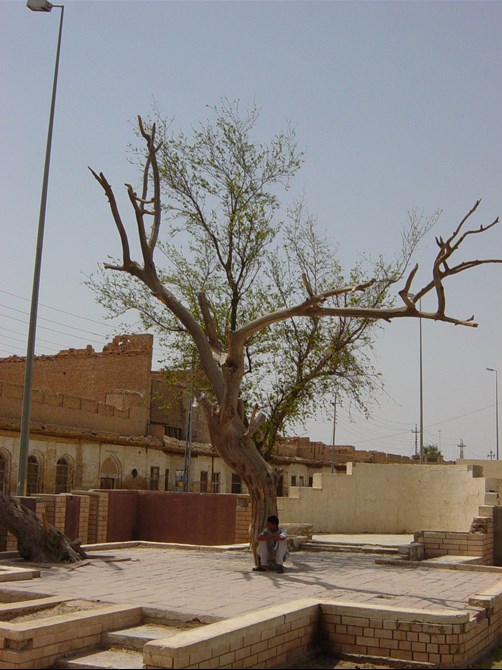
Adam’s Tree at Qurna – believed to be the site of the Garden of Eden

Above: The mighty River Tigris, a formidable military obstacle
Qurna was captured on 9 December 1914 further securing the Shatt-al-Arab waterway. In April 1915 General Sir John Nixon took over as Force commander from General Barrett as the force expanded to that of an Army Corps: 6th Division under command of Major General Charles Townsend; 12th Division under Major General George Gorringe; and 6th Cavalry Brigade commanded by Major General Sir Charles Melliss VC. It was Melliss who would see action first when he saw off the Turkish threat to Shaiba, 10 miles west of Basra; at a cost of 1,257 British casualties. The next Turkish threat was from the north of Basra, this time met by Major General Gorringe who soon had the enemy withdrawing to Al-Amara. General Nixon, believing his opponent to be weak then, with the blessing of the Viceroy’s Office in India and London, ordered Major General Townsend to take Al-Amara. This was no mean feat as troops had to cope with the marshlands and flood plains following what had been some of the heaviest rains for many years. Despite this the operation was a complete success with Al-Amara being captured with only 4 soldiers being killed and 24 injured. Townsend had been audacious and he had been successful, on the back of which he must have felt invincible against the Turks.

Above: Marshlands of Southern Iraq through which British Forces advanced on Al-Amara in September 2015
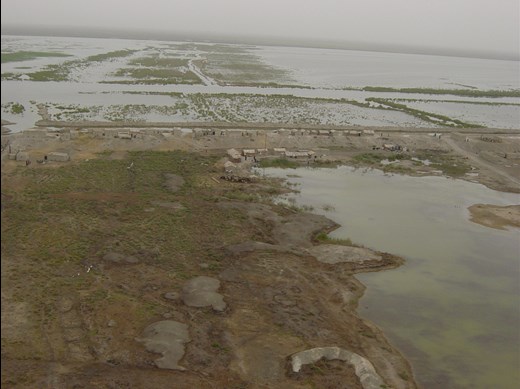
Above: Marsh Arabs in Southern Iraq; in 1915 they were allied to the Turks
The next Turkish stronghold to fall was Nasiriya which was captured on 25 July 1915 by Major General Gorringe leading the 12th Division. Total British casualties were 104 dead and 429 wounded. Each success, which was aimed at securing Basra, raised its own threat, which for Nasiriya was Kut. General Nixon was keen to press on further and no doubt had Baghdad in his sights. The Turkish division in Kut (35th Division) was reported to be weak. Meanwhile Major General Townsend had been on sick leave in India – there is much evidence that at this stage he had private concerns on the merit of advancing his forces from Al-Amara to Kut; not that he shared these with General Dixon on his return to theatre. With 11,000 troops, 28 guns and 40 machine-guns at his disposal the assault began on the 27 September 1915, opposing him was estimated to be about 6,000 Turks with 38 guns. Fighting was fierce with the Turks well dug in, but by the end of the following day the enemy had been driven from their positions, but not beaten. The Battle of Kut had been another great success for Major General Townsend who now found himself some 60 miles north of Kut with supply lines which were becoming tenuous to say the least. He expressed his concerns regarding a push for Baghdad, which was still some 50 miles away, to General Nixon. For his part Nixon saw an opportunity for some good news given how badly the War was going elsewhere. He reinforced Townsend and on the 24 October 1915, the order was given to advance to Baghdad.
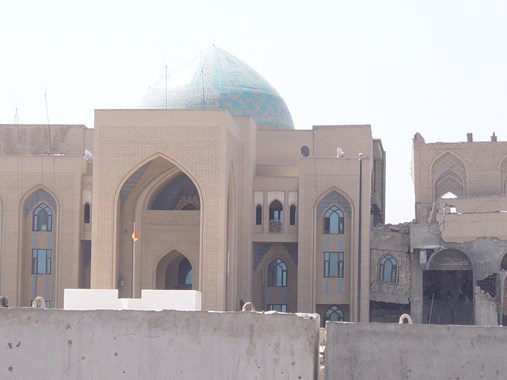
Above: One of Uday Hussain’s Palaces in Baghdad
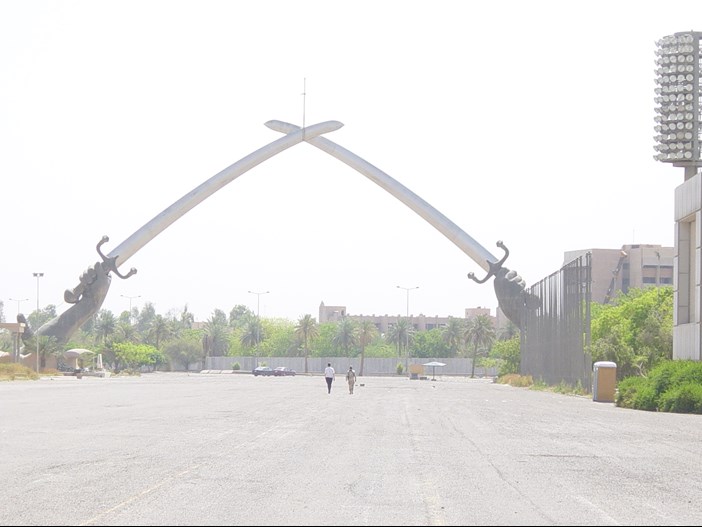
Above: The famous crossed-swords in Baghdad
The 6th Division won a small engagement at Kutuniya on their way to engage the main enemy force at Ctesiphon, 18 miles south-east of Baghdad. The Turks were positioned in 2 main lines of defence; they numbered about 18,000 having been reinforced with the 45th Division who had been located in Baghdad. The battle began on 22 November 1915 with the British attacking in three columns and although casualties were high on both sides they managed to push the Turks back to the River Diala and fight off a counter attack. At this point the commanders on both sides were contemplating withdrawing from the field, and it was the British who blinked first. Townsend was concerned that his force was perilously weakened and recognised that his lines of support were stretched. On 28 November he decided to withdraw to Kut and on 3 December he informed General Nixon of his intention to defend the town and await reinforcements. He issued the following communique to his troops:
‘I intend to defend Kut-al-Amara and not retire and further. Reinforcements are being sent at once from Basra to relive us. The honour of our mother country and the Empire demands that we work hart and soul in the defence of this place. We must dig deep and dig in quickly, and the the enemy’s shells will do little damage. We have ample food and ammunition, but commanding officers must husband the ammunition and not throw it away uselessly. The way you have managed to retire some 80 or 90 miles under the very noses of the Turks is nothing short of splendid, and speaks eloquently for the courage and discipline of this force.’
And the rest, as they say, is history.
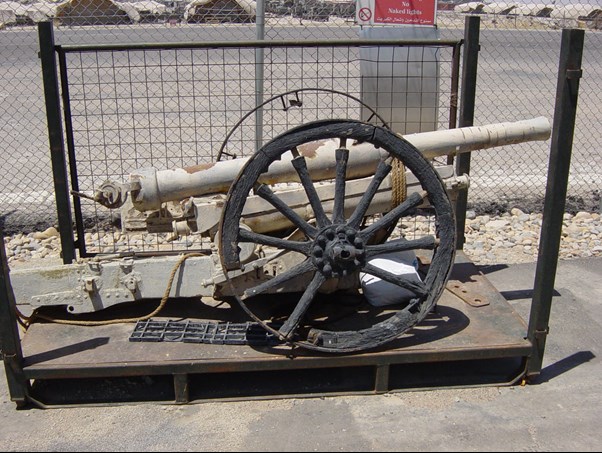
Above: Armstrong Screw Gun, captured by Turkish Forces
The CWGC cemetery in Kut is in the heart of the old town surrounded on three sides by walls and open to a narrow market street on the other. The Islamic faith does not allow for the building of dwellings on land where infidels are buried and so it has never been built upon. That does not stop it from being used for other purposes and the US contingent on site said that they had cleared away a lot of rubbish and foliage. They had also stood up a number of the grave stones and made a new sword to attach to the cross of sacrifice, and had repaired the front wall; installing new railings. The condition of the headstones was generally poor, with many being illegible.
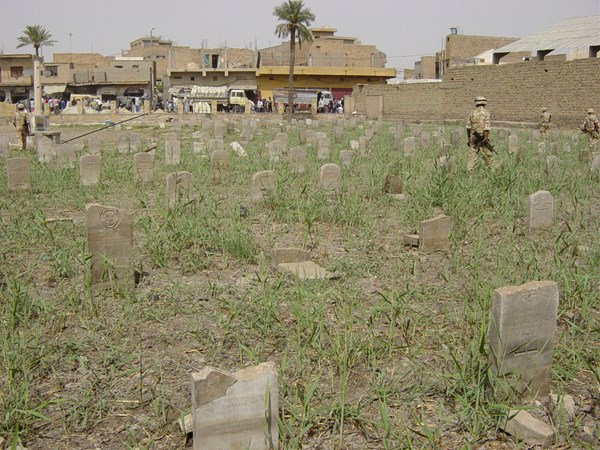
Above: Kut War Cemetery, 2003 - looking towards the open side
In total 421 British troops are buried in Kut, of whom all but 11 were originally identified. Amongst those which you could still read there were a number of Norfolk Regiment casualties and the dates spread from December 1915 to November 1917.
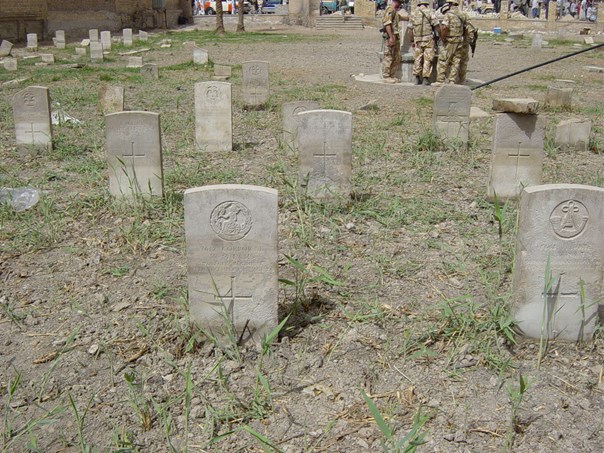
Above: Headstone of Corporal William Lamb of the Norfolk Regiment in Kut War Cemetery
The most senior officer I could find was Brigadier General Hoghton.

Above: Headstone of Brigadier General Frederick Hoghton 69th Punjabis Regiment in Kut War Cemetery
Kut War Cemetery was established by the 6th (Poona) Division between October 1915 and May 1916 and was increased in size when graves were brought in from other sites after the War. The US team leader who led us in said that despite employing local labour there had been much disquiet at money being spent on the graveyard given the amount of local poverty. In 2014 the CWGC carried out a full refurbishment of the site having found that it was once more in poor condition.
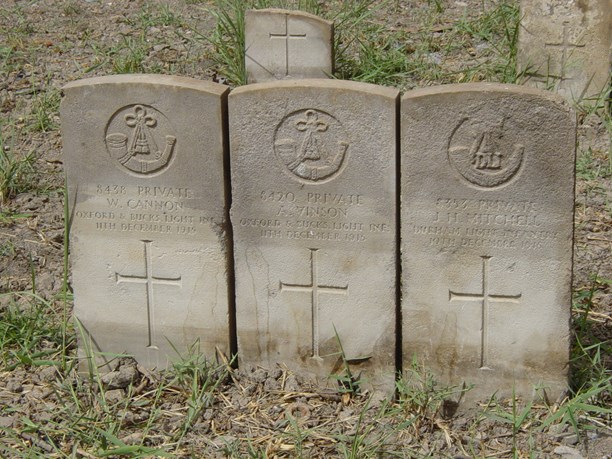
Above: William Cannon, Arthur Vinson and James Mitchell who rest side by side at Kut War Cemetery
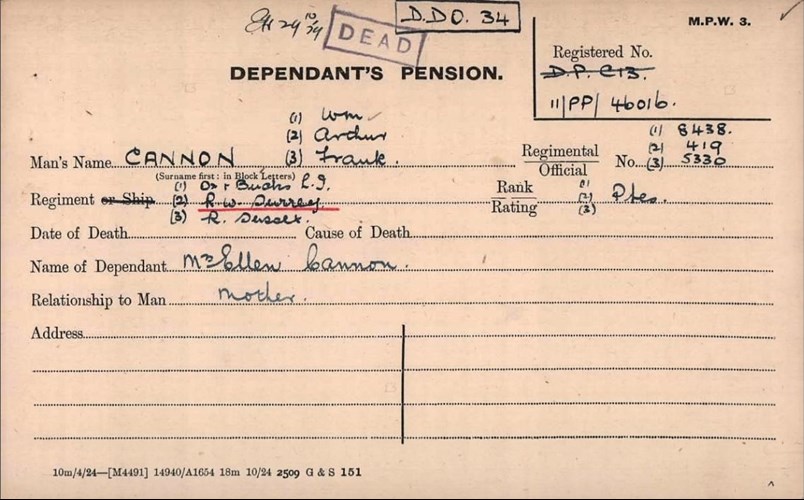
Above: William Cannon's Pension Record Card
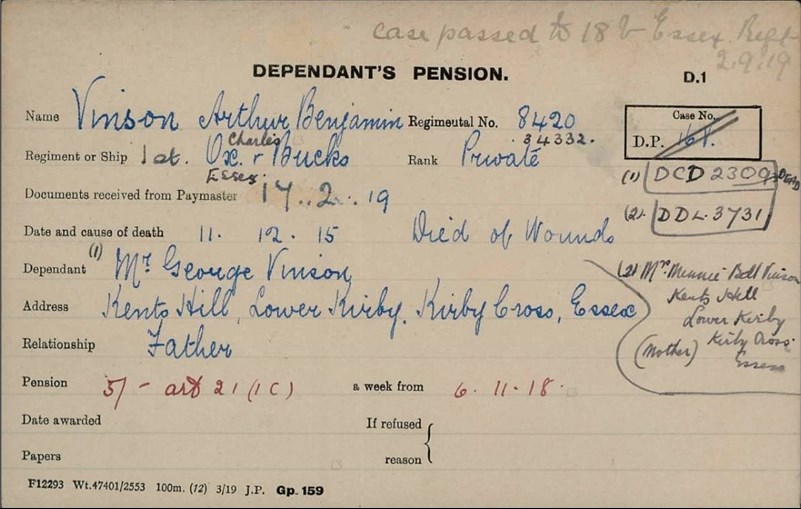
Above: Arthur Vinson's Pension Record Card

Above: James Mitchell's Pension Record Card. These cards are part of those saved by The Western Front Association.
Al-Amara was occupied by the Mesopotamian Expeditionary Force on 3 June 1915 and immediately became a centre for hospitals, at its height there were 7 general hospitals and some smaller units stationed in the area. The Cemetery contains 4,633 casualties of which more than 3,000 were brought into the cemetery after hostilities. The CWGC site in Al-Amara is on the edge of the town between the left bank of the river Tigris and the Chahaila Canal. The Indian Army cemetery in 2003 was no more than a clay area on which the local children played football. The only remaining part of the cemetery was the gate with its high sandstone dome and inscription still intact. There are reported to be over 5,000 burials, however no comprehensive records were kept and the graves of only nine casualties, all of whom died after November 1918, are identified.
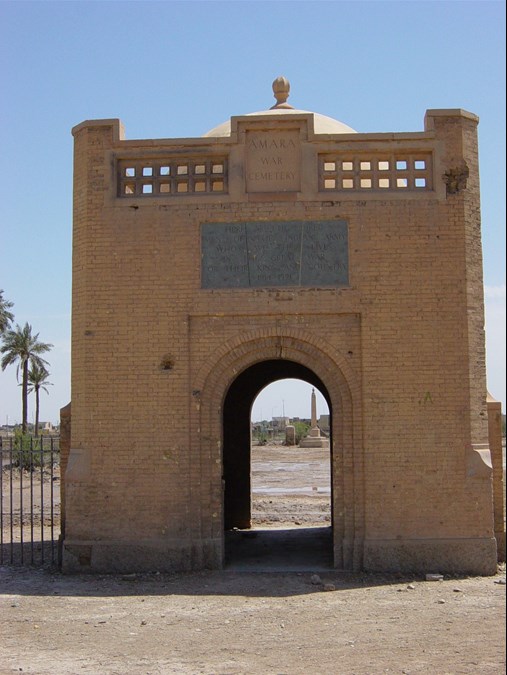
Above: The Gate, all that is left of the India War Cemetery Al-Amara (the 'Amara (Left Bank) Indian War Cemetery')

Above: Inscription of the Indiam Army Cemetery Gate Al-Amara
Adjacent to the Indian cemetery is the British one. By contrast to the Indian cemetery the perimeter wall and iron railings were in good condition. In one corner was a small dwelling with the entrance gate. The man who lived there with his family was only too happy to show visitors around; a box of water and $20 helped. He had part of one headstone, but given that the headstones were removed in 1933 because of the levels of salt in the ground it was surprising that he had that bit.
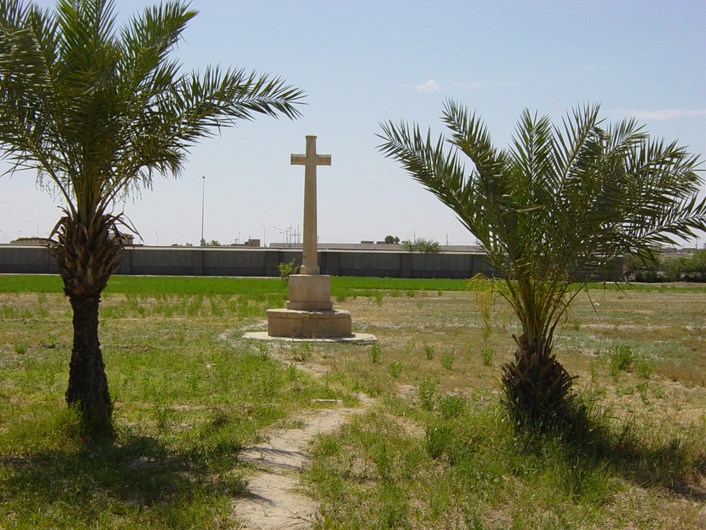
Above: Amara War Cemetery: a touch of green in the desert of southern Iraq

Above: The Cross of sacrifice at Amara War Cemetery
The main graveyard was green as the keeper appeared to be growing some form of crop on the land. This was probably a good thing during Saddam Hussein's time as it prevented the graveyard from suffering what had happened in Kut and it did look like a small parcel of land which would be forever England. The names of those buried in the cemetery are on a wall and in the most part were legible. There was a mix of regiments and units including cyclist battalions and Royal Flying Corps.

Above: The inscription at Amara War Cemetery
The wording reads "1914-1920. The Offices and men of the Forces of the British Empire whose names are here recorded are buried or commemorated in this cemetery which contains also the graves of 925 of their comrades whose names are not known."

Above: Part of the Screen Wall at Amara War Cemetery, the headstones having been removed in 1933 due to the soil conditions in the cemetery.
The Basra CWGC cemetery was in a similar state to that of Kut. The Basara Indian cemetery, which contains 392 casualties, was overgrown with vegetation and a number of the headstones had been stacked neatly in a small building. The Basra Cremation Memorial, which stands within Basra Indian Forces Cemetery, commemorates 1,032 soldiers whose remains were cremated in accordance with their faith. The cemetery in which the memorial stands contains burials of both wars. As well as rubbish, discarded munitions were clear to see and it wasn't a place for exploring. Also alongside the Indian Forces Cemetery is the Basra (Tanooma Chinese) Memorial. The other side of the road was the British cemetery which contains a total of 1032 casualties from both WWI and WWII. Here every stone had been pushed over and once again the local children were using the area to play on.
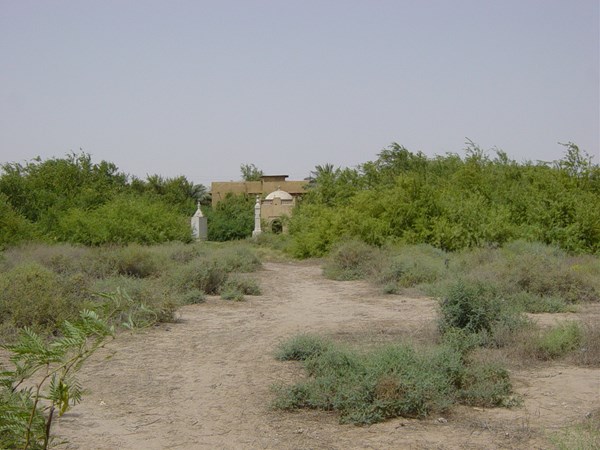
Above: Basra Indian Forces Cemetery

Above: Basra Cremation Memorial, for those whose religious beliefs were that their bodies were to be consumed by fire

Above: Headstones neatly stacked in the Indian Forces Cemetery, Basra
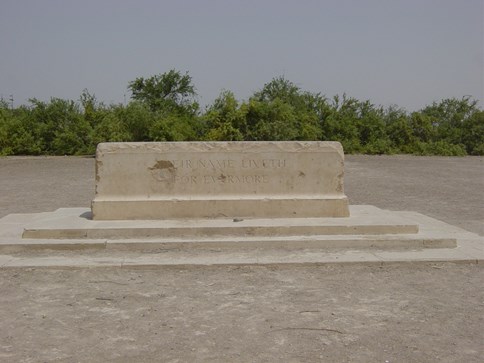
Above: Basra War Cemetery. Little remains of the cemetery, all of the headstones having been pushed over and damaged
The other memorial, and probably the most impressive is the Basra Memorial which until 1997 was located on the main quay of the naval dockyard at Maqil, on the west bank of the Shatt-al-Arab, about 8 kilometres north of Basra. Due to the sensitivity of the site, the Memorial was moved by presidential decree to its current location 32 kilometres along the road to Nasiriyah; near to Shaiba Airfield - and is now often referred to as the Shaiba Memorial. Casualties are listed under the regiment they served with in rank order. Whereas the British casualties are all named the Indian Army other ranks are given as a quantity. The structure was moved in its entirety and painstakingly rebuilt, which would not have been an easy task. That said, 6 years after being moved, 2003, the memorial was showing a lot of water damage and some of the panels had started to fall off their walls.
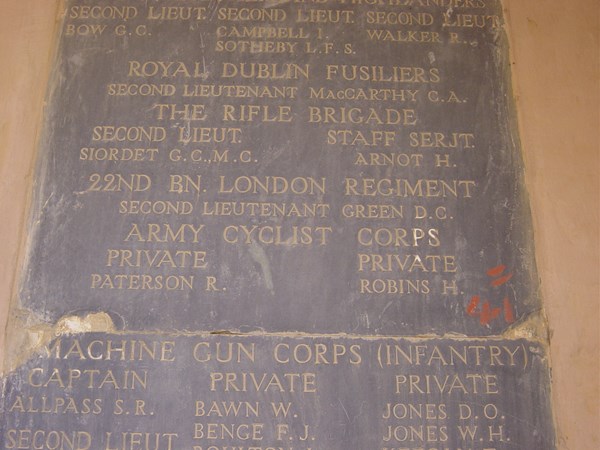
Basra Memorial, A section of panel, including the RDF, 22/London, Army Cyclist Corps and MGC.

Above: The Pension Record Card for R Paterson, who is named on the memorial panel above.
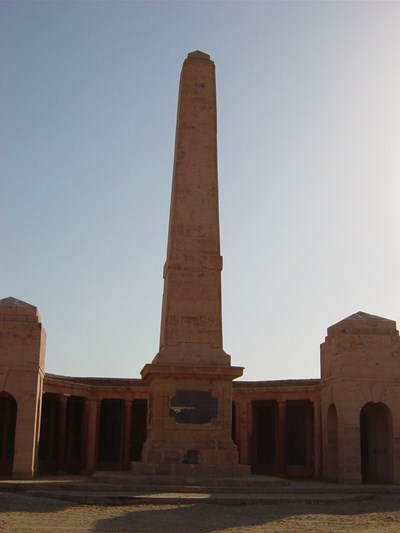
Above: Basra Memorial central needle
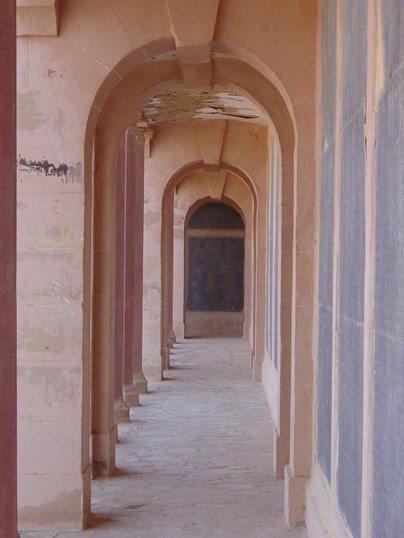
Above: Basra Memorial moved from its original location 1997 showing water damage to the ceiling
Nevertheless it remains an impressive memorial commemorating more than 40,500 members of the Commonwealth forces who died in the operations in Mesopotamia from the Autumn of 1914 to the end of August 1921 and whose graves are not known. The memorial was designed by Edward Warren and unveiled by Sir Gilbert Clayton on the 27th March 1929.
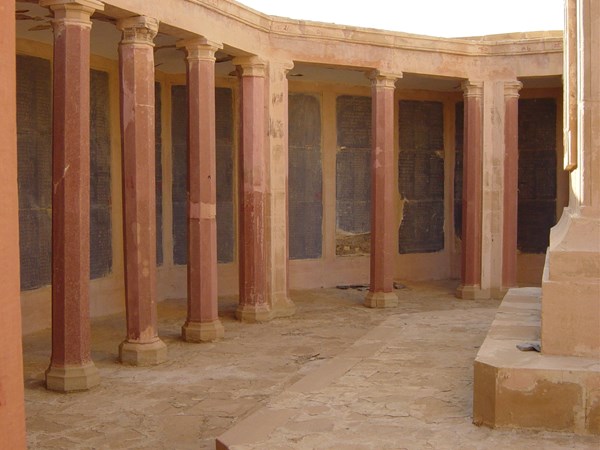
Above: Columns and panels at the Basra Memorial, which commemorates more than 40,500 British and commonwealth forces who died in Mesopotamia

Above: An Indian Army panel from the Basra memorial, note how 'other ranks' are recorded simply by number not by name.
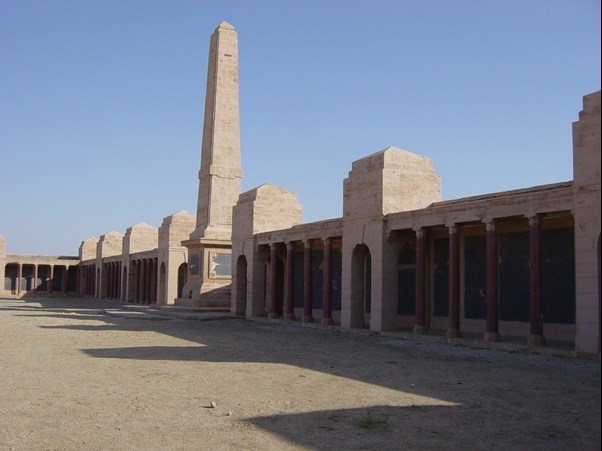
Above: The Basra Memorial, an impressive monument, now on the edge of the desert

Above: The author with the man who maintained the CWGC in Al-Amara in 2003
Article submitted by Major General (Retd) M A Armstrong JP DL





